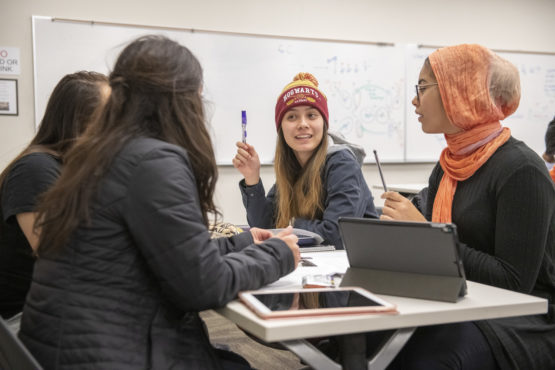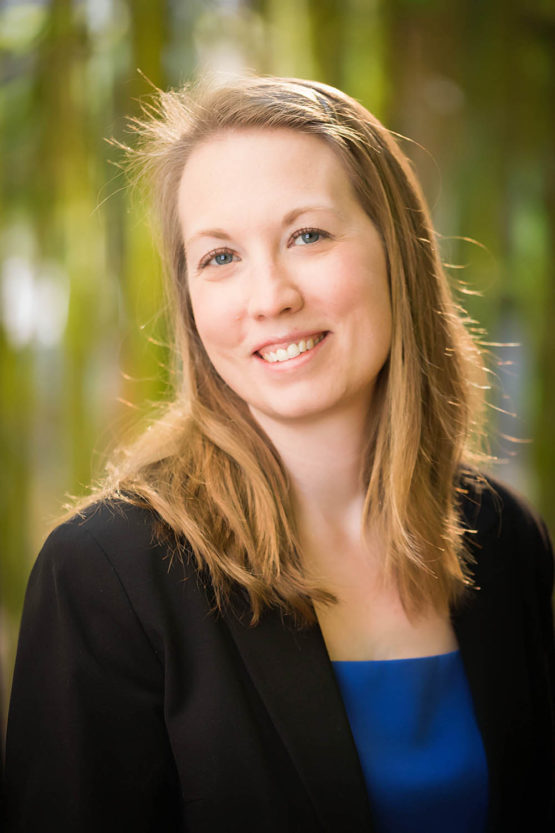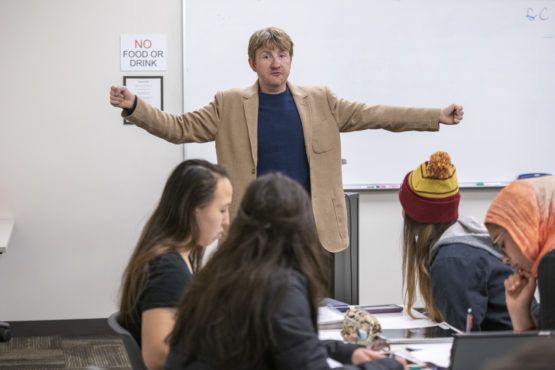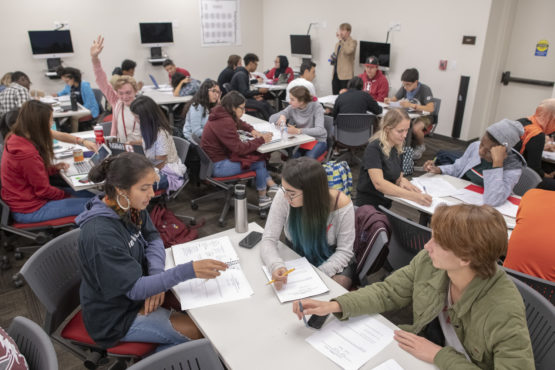Chemistry companion courses offer students extra help and a community
First generation or low-income students arrive to college chemistry courses at a disadvantage – lacking the honors or AP science courses that others take for granted. A companion course series helps ensure that no undergraduates taking chemistry are left behind.
Hundreds of incoming Stanford freshmen take the introductory chemistry series every year, but before they can even attend the first lecture or take the first exam, some are already behind.

Paisley Richards and Nour Mary Aissaoui, right, work with their group on problems on polarity and charge in Chem 31AC. (Image credit: L.A. Cicero)
Stanford’s continued push to diversify its student body and increase enrollment among first generation and low-income students means that the number of students who start university at an academic disadvantage, especially in the sciences, is also rising.
“If your high school didn’t offer AP or honors chemistry, or if your high school did not have a qualified chemistry instructor, then you’re at a different starting point than someone who went through a strong high school chemistry course,” said senior chemistry lecturer Jennifer Schwartz Poehlmann.
To help ensure that every student taking the chemistry introductory sequence has a chance to succeed, the Chemistry Department offers “companion courses” for each of the three courses in the first-year sequence (Chem 31A, 31B and 33).
First offered in 2010, the companion courses provide students with additional opportunities to work through challenging problems in a small class setting. The classes are usually made up of no more than 50 students and emphasize group work and study skills.
“The companion course is a community,” said chemistry lecturer Charlie Cox, who co-teaches the course. “We have time to explore problem-solving in greater depth and address questions that may not be addressed in lecture.”
Any student can apply for the companion courses, but preference is given to undergrads who are part of the Leland Scholars Program, a summer program designed to ease the college transition for first-generation, low-income, and minority students who express an interest in studying science, technology, engineering and math.
Instructors identify other students who might benefit through a survey they administer at the beginning of each quarter asking students about their study habits and chemistry knowledge.
“We find the survey to be pretty good at getting a sense of how confident students are coming into the course and what their study skills are,” Schwartz Poehlmann said. “Because there are two big pieces to being successful in a science course: What’s your background in it? But more importantly, how do you study? Students who focus their study time more effectively on understanding concepts and applying them to problem-solving instead of just memorizing content will be more successful in these courses and beyond.”
A new language
The companion courses meet for 90 minutes every Tuesday and Thursday, sandwiched between the main courses, which meet Monday, Wednesday and Friday.
The course structure is intentional, Schwartz Poehlmann said. “When you take a new language course, you go to class every day because you can’t cram a language into one day. When you’re taking a science course, you’re essentially learning a new language, so why would you teach it any differently?”
In the companion courses, students break up into groups and tackle chemistry problems together. For example, a group might be given four multiple choice questions. The students get five minutes to work by themselves and then they have to pick one of the questions and explain it to the group. “That way, everybody gets an opportunity to teach and to be exposed to different problem-solving approaches,” Schwartz Poehlmann said. “Students often remark in their feedback that it’s really helpful to learn other perspectives. They come away with a better understanding of the material.”
The group activities also serve another purpose. “It’s also about building a cohort and an environment of support where students can see that they’re not the only ones struggling and that they can be successful together,” Schwartz Poehlmann said.
The missing link
By all accounts, the chemistry companion courses have been a success. By the end of the three-course series, students who have taken the companion courses are doing as well as those who took AP chemistry in high school. Many have gone on to major in the sciences at Stanford. “These students become my front-row students who are asking more questions than my strong AP students,” Schwartz Poehlmann said.
“This is the missing link to 31A,” wrote one student in a course evaluation. Another student, who came from a low-income community where only about 50 percent of the students in his high school graduated, wrote: “In 33C I learned how to best use my study time. I learned to assess my own retention and application of material by not only reading the material, but critically engaging with it. Learning to think outside of the ‘read and regurgitate’ framework was useful for me in navigating every science course I have taken ever since.”
Many of the companion course students form long-lasting study groups that persist throughout their time at Stanford. “When put in an inclusive learning community such as the one present in these companion courses, you get a sense of what truly matters when taking any course: the ability to leave the class and be able to say that you are leaving knowing more about the subject matter,” said Karime Laborin, a sophomore now majoring in mechanical engineering.
Laborin said she partially credits chemistry companion courses with helping give her the personal and academic confidence to pursue her interest in engineering. “Validation and assistance go a long way,” she said.
To read all stories about Stanford science, subscribe to the biweekly Stanford Science Digest.



